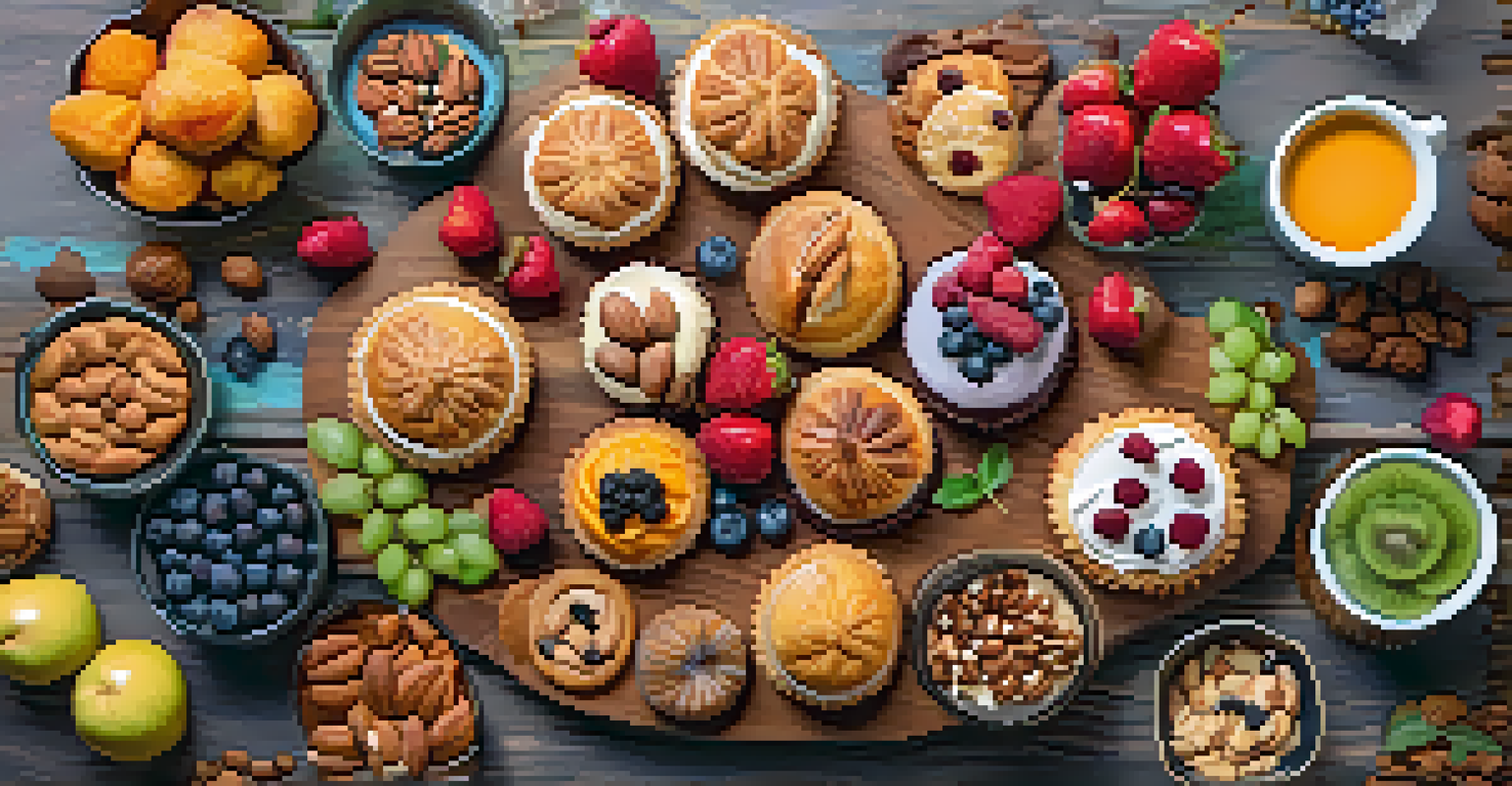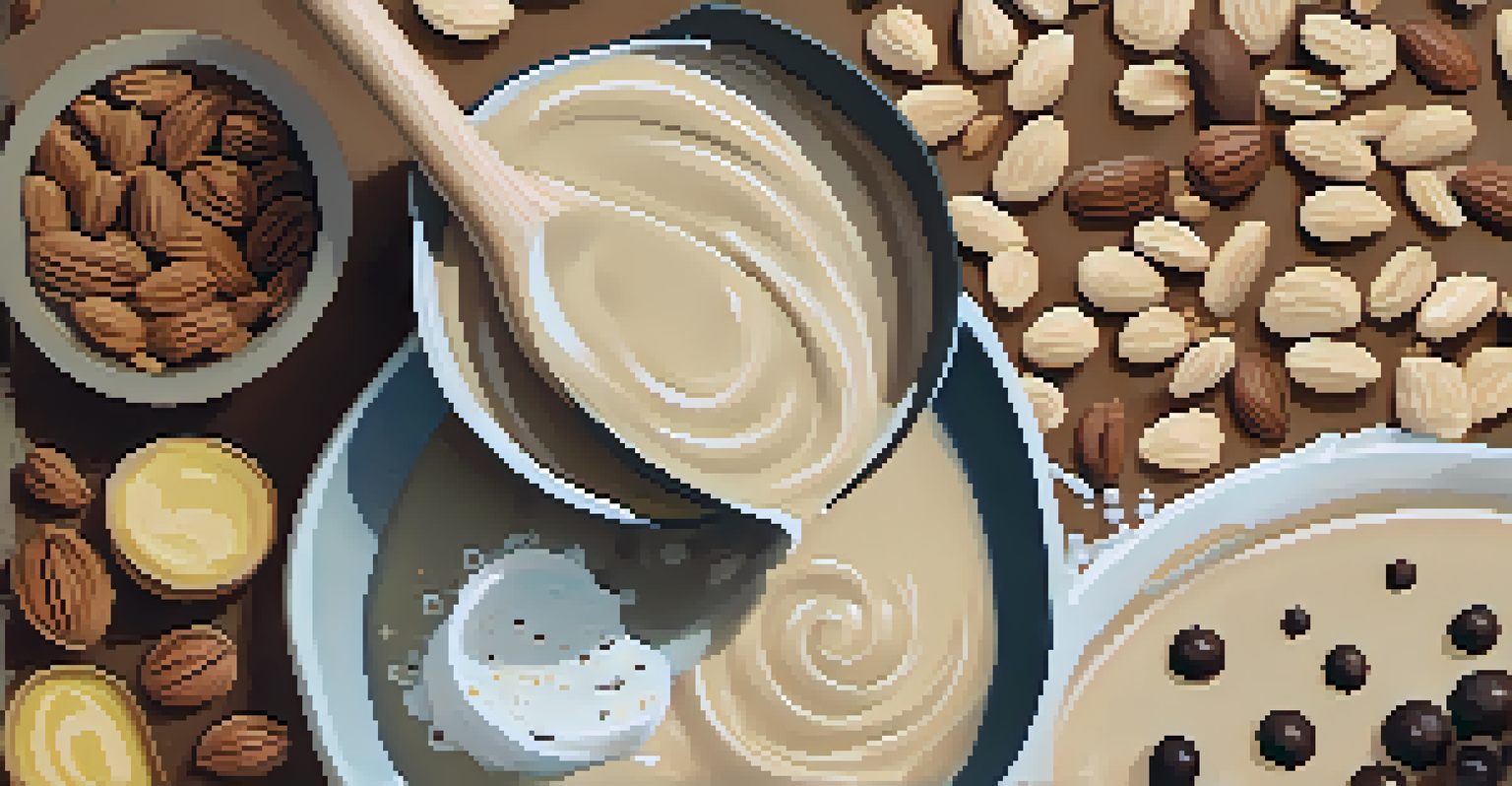The Science of Vegan Baking: Tips for Perfect Pastries

Understanding the Basics of Vegan Baking Ingredients
Vegan baking replaces traditional animal-based ingredients with plant-based alternatives, which can change the texture and flavor of your pastries. For instance, instead of eggs, you might use flaxseed meal or applesauce, each offering unique moisture and binding properties. Understanding these substitutions is crucial since they impact how your baked goods rise and hold together.
Baking is both an art and a science; it requires precision, creativity, and a willingness to experiment.
It's also important to consider the leavening agents you choose. Baking soda and baking powder are often used in vegan recipes, but their effectiveness can vary based on the acidity of other ingredients. A bit of lemon juice or vinegar can enhance the leavening process, ensuring your pastries rise beautifully.
Finally, don’t overlook the role of fats in vegan baking. Coconut oil, avocado, and nut butters can provide the richness that butter would in traditional recipes. Choosing the right fat can make a significant difference in achieving that perfect pastry consistency and flavor.
Flour Choices: Finding the Best Vegan Options
Not all flours are created equal, especially in vegan baking. All-purpose flour is a common choice, but experimenting with whole wheat or almond flour can add depth to your pastries. Each type of flour has its own protein content and gluten formation, influencing the texture of your final product.

For gluten-free options, there are excellent alternatives like oat flour or chickpea flour, which can yield tasty results. However, gluten-free baking often requires a blend of flours to achieve the right texture, so don’t hesitate to experiment with different combinations.
Key Vegan Baking Ingredients
Understanding plant-based substitutes like flaxseed meal and coconut oil is crucial for achieving the right texture and flavor in vegan pastries.
Remember, the flour you choose will also affect the moisture content of your batter. This means you might need to adjust your liquid ingredients accordingly. Keeping an eye on this balance ensures that you don’t end up with overly dry or wet pastries.
Sweeteners: How to Choose the Right Type
When it comes to sweetening vegan pastries, there are more options than just refined sugar. Natural sweeteners like maple syrup, agave nectar, or coconut sugar can add unique flavors while also bringing moisture. Each sweetener has its own level of sweetness and moisture content, so it's essential to adjust your recipes accordingly.
The best part of baking is that it allows you to share a piece of yourself with others.
Liquid sweeteners, like maple syrup, might require you to reduce other liquids in the recipe to maintain the right consistency. On the other hand, granulated sweeteners can change the texture, making your pastries crispier or denser based on how they interact with the other ingredients.
Don’t forget to consider the flavor profile of your sweetener. For example, brown sugar will lend a rich, caramel-like taste, while agave is milder. Choosing the right sweetener not only affects the sweetness but also enhances the overall flavor of your baked goods.
Egg Replacements: Binding and Moisture Solutions
Eggs play a crucial role in traditional baking, providing moisture and acting as a binder. In vegan baking, there are several effective alternatives such as flaxseed meal, chia seeds, or commercial egg replacers. Each option can bring different qualities to your pastries, so choosing the right one is key.
For instance, flaxseed meal mixed with water creates a gel-like consistency that mimics the binding properties of eggs, making it perfect for cookies and muffins. Meanwhile, aquafaba— the liquid from chickpeas—can be whipped to create a light, airy texture suitable for cakes and meringues.
Choosing the Right Flours
Experimenting with different types of flour, including gluten-free options, can significantly influence the moisture and texture of your baked goods.
Experimenting with different egg substitutes can help you find the perfect match for your specific recipe. Understanding how each replacement functions will ensure that your pastries turn out consistently delicious.
The Importance of Temperature in Vegan Baking
Temperature can significantly influence the outcome of your vegan baked goods. For example, using room temperature ingredients like milk or butter alternatives helps create a smoother batter and allows for better incorporation of air, leading to fluffier results. On the flip side, cold ingredients can lead to denser pastries.
When it comes to baking itself, preheating your oven is essential. If the oven isn’t hot enough when you place your pastries inside, they may spread rather than rise, leaving you with less-than-desirable results. An oven thermometer can help ensure your oven is at the correct temperature.
Lastly, cooling your baked goods properly is just as important. Allowing pastries to cool on a wire rack prevents sogginess and helps maintain their structure. The right cooling method can make all the difference in achieving that perfect texture.
Mixing Techniques: How to Achieve the Right Consistency
How you mix your ingredients can affect the final texture of your pastries. For instance, overmixing can lead to tough baked goods, while undermixing can result in lumps. It’s essential to find that sweet spot where everything is combined without overworking the batter.
Different mixing techniques can also yield varying results. Folding in dry ingredients gently can help retain air, resulting in lighter pastries, while whisking might be better for incorporating wet ingredients. Understanding these techniques will help you master the art of vegan baking.
Perfecting Baking Techniques
Mastering mixing methods and considering ingredient temperatures are essential for creating consistently delicious vegan treats.
Moreover, the order in which you mix your ingredients matters too. Starting with dry ingredients and then adding wet ones can help create a more uniform batter. This foundational knowledge can enhance your baking skills, leading to consistently delicious vegan treats.
Experimenting with Flavors: Spices and Add-ins
Vegan baking offers a fantastic opportunity to experiment with flavors. Incorporating spices like cinnamon, nutmeg, or cardamom can elevate your pastries and provide unique taste experiences. Don't be afraid to get creative with your flavor combinations; they can transform a simple recipe into something extraordinary.
Add-ins such as nuts, seeds, or dried fruits not only enhance flavor but can also provide interesting textures. For example, adding chopped walnuts can give a satisfying crunch to a banana bread, while raisins can introduce a touch of sweetness. Finding the right balance of add-ins can create a delightful contrast in your baked goods.

Lastly, think about using extracts like vanilla or almond to amplify the flavor profile of your pastries. A small amount can go a long way in enhancing the taste without overpowering the other ingredients. Experimentation is key, so don’t hesitate to try new combinations!